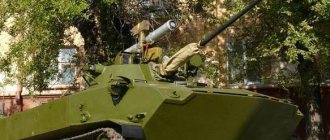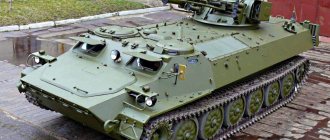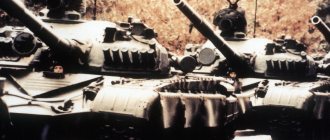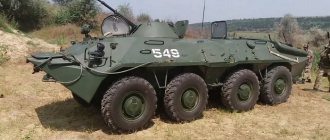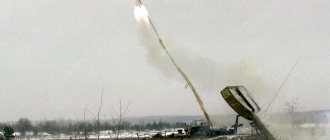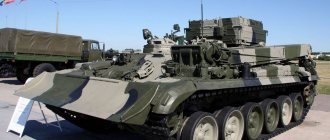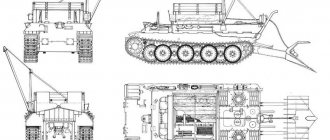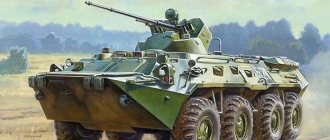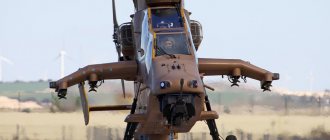BRDM-2
(Armored Reconnaissance and Patrol Vehicle-2) - is a further development of the BRDM-1.
Serially produced from 1963 to 1989 by the Arzamas Machine-Building Plant (as well as under license in Poland, Czechoslovakia and Yugoslavia). BRDM-2 has low security; the armor protects against small arms bullets and shrapnel. The main feature of the vehicle is its very high cross-country ability. In addition to the main all-wheel drive chassis with adjustable tire pressure, in the middle part of the body there are special additional retractable wheels, which allow, in particular, to overcome significant ditches and trenches. Currently used to one degree or another by intelligence units in more than 50 countries. In the troops he has the nickname “Bardak”. In the USSR, production was completed in November 1989. Production continues under license in Poland.
HISTORY OF CREATION AND PRODUCTION
The combat reconnaissance and patrol vehicle was developed at the design bureau of the Gorky Automobile Plant. The work was supervised by V.A. Dedkov. On May 22, 1962, the vehicle was put into service. Serial production of the vehicle was organized in 1963 at GAZ, and from 1965 at the Arzamas Machine-Building Plant and continued until 1989.
- BRDM-2
(GAZ-41-06) - basic model. Produced since 1963 - BRDM-2 "Fox"
(GAZ-41-10) - basic model. Produced since 1967. With automatic ESD and additional night vision devices - BRDM-2A
- modernized
DESIGN DESCRIPTION
The BRDM-2 has a layout with the control compartment located in the front, the fighting compartment in the middle, and the engine compartment in the rear of the vehicle. The crew of the BRDM consists of four people: the commander and driver, located in the control compartment on the right and left, respectively, the gunner, located in the turret, and the observer, occupying a place on the left or right side in the fighting compartment.
MANAGEMENT DEPARTMENT
The control compartment is located in the bow of the hull. The control compartment houses the machine controls, as well as the following equipment:
- Seats for commander and driver;
- Instrumentation;
- Radio station;
- Observation devices.
The seats have a position adjustment system. In the niche of the right front wheel there is a bracket for the DP-3B radiometer. The remote unit of the device is fixed in the housing on the front bottom sheet.
COMBAT COMPARTMENT
The fighting compartment is located in the middle part of the vehicle. In order to access the power plant from inside the vehicle, there is a partition in the rear part of the fighting compartment in which special hatches are installed.
The fighting compartment has two seats for the vehicle's crew. A shoulder strap is installed on the roof, on which the vehicle's turret is located. The turret has a hanging seat to accommodate the shooter. In the center of the floor there is a sealed casing, under which the transfer case is located. In addition, there is a special niche in the floor for placing tools. The niche is closed with a hinged lid.
POWER PLANT DEPARTMENT
The power unit compartment is located at the rear of the housing. The power plant compartment houses:
- Drive for manual engine start;
- Engine;
- Starter heater fuel tank;
- Generator set;
- Filter ventilation unit;
- Transmission;
- Air cylinders;
- Water and oil radiators;
- Accumulator battery;
- Water and oil heat exchangers;
- Cardan drive of water jet propulsion;
- Compressor;
- Evacuation valve;
- Starting heater;
- Electric water pump.
| Armor penetration table for KPVT | |||||
| Bullet \ Distance, m | 100 | 250 | 500 | 750 | 1000 |
| B-32 | |||||
| (tilt angle 0°, homogeneous armor) | 30; 27 | ||||
| BS | |||||
| (tilt angle 0°, homogeneous armor) | 50 | ||||
| It should be remembered that at different times and in different countries different methods for determining armor penetration were used. As a consequence, direct comparison with similar data from other guns is often difficult. | |||||
ENGINE AND TRANSMISSION
Spring suspension with longitudinal semi-elliptical springs.
The BRDM-2 is equipped with a GAZ-41 four-stroke gasoline engine. Engine power is 140 hp. The engine uses a combined lubrication system (pressure and splash). The oil pump is a two-section gear type. A jet-driven centrifugal oil filter is also used. The total capacity of fuel tanks is 280 liters.
The transmission is mechanical. Has 4 forward and one reverse gears. The clutch is single-disc, damper, with an outer diameter of the driven disc of 300 mm.
Design Features
The layout of the BRDM-2 is as follows:
- In front is the control compartment. Here there are controls, a radio station, navigation devices, places for the driver and commander, and devices for monitoring the terrain.
- In the middle is the fighting compartment. Its center is a tower on which a machine gun is mounted. There is also ammunition, hydraulic lifts for additional wheels, and two seats for scouts.
- In the stern is the engine compartment. It is isolated from the rest of the machine by a sealed partition with a filter and ventilation unit. The power unit can be accessed through hinged doors.
The body itself is made of rolled steel sheets coated with a layer of armor (6-10 mm). This protects the vehicle from shrapnel, small arms fire and small-caliber mines.
MODIFICATIONS
- BRDM-2-23M
- Armenian version of the modernization. An SMD-21-08 diesel engine is installed. The KPVT and PKT machine guns were replaced with a 23-mm 2A14 automatic cannon, and a ventilation valve was installed on the turret to remove powder gases. - BRDM-2M(A)
- a modernized version of the BRDM-2. Manufacturer: Arzamas Machine-Building Plant. The vehicle has been lightened - the side wheel mechanisms for increasing cross-country ability have been removed, and trapezoidal doors from the BTR-70 have appeared instead. The suspension is unified with the BTR-80. Instead of a gasoline engine, a D-245.9 turbodiesel engine with a power of 136 hp is installed. The BRDM is equipped with a BPU-1 turret armed with a 14.5 mm KPVT machine gun and a 7.62 mm PKT machine gun (and the KPVT firing angle is increased to +60°) and is equipped with modern radio stations R-163 or R-173. - BRDM-2LD
is a Ukrainian modernization of BRDM-2 (with a Ukrainian-made SMD-21-08 diesel engine), developed under the Bulb R&D program in 1999 by the Nikolaev Mechanical Repair Plant State Enterprise. 10 pieces. used by the Ukrainian contingent in Kosovo. Production discontinued due to bankruptcy (manufacturer of SMD series engines) - BRDM-2DI “Khazar”
is a Ukrainian modernization of the BRDM-2, developed in 2005 at the Nikolaev Mechanical Repair Plant, equipped with an FPT IVECO Tector diesel engine with a pre-heater, a thermal imager and a new weapons system. - BRDM-2DP
is a Ukrainian modernization of BRDM-2, developed by OJSC Mayak Plant (Kiev). Lightweight modification (the turret and side wheel mechanisms for increasing maneuverability were removed), a side door for landing was equipped, a diesel engine and a device for overcoming trenches and trenches were installed, the armament was changed (a 12.7 mm DShKM bow machine gun and 2 onboard 7.62 mm machine guns were installed SGMB machine gun). The machine can also be equipped with removable anti-cumulative nets. - BRDM-2T
is a Ukrainian modernization of BRDM-2, developed in 2013 (Kiev). Additional wheels have been removed. The side landing hatches, like those of the BTR-70, the R-173 radio station, a new D245.30E2 diesel engine with a power of 155 hp, front and rear marker lights of the BTR-70, new wheels with tubeless tires were installed. The turret was dismantled, a 12.7 mm NSVT machine gun and a 7.62 mm PKT machine gun were installed. It is also possible to install combat modules. - BRDM-2MB1
is a Belarusian modernization of the BRDM-2, produced by JSC 140 Repair Plant. Water-jet propulsors and additional wheels were dismantled. The side landing hatches, the R-173 radio station, a new D245.30E2 diesel engine with a power of 155 hp, the Adunok combat module and a video surveillance system were installed. Armed with a 12.7 mm NSVT machine gun. The crew has been increased to 7 people. - ZKDM “Zubastic”
is a modernized version developed in Azerbaijan. Equipped with enhanced mine protection, a new turret (which contains a 23-mm double-barreled GSh-23 cannon, a 7.62-mm machine gun, a 30-mm automatic grenade launcher AGS-30 and four 81-mm smoke grenade launchers - two on each side of the turret) , a new diesel engine D-245.30E2 with a power of 150 hp. Water-jet propulsors and additional wheels were dismantled. Side landing hatches installed One demonstration model was developed in September 2013, in December 2013 it was sent for testing - BRDM-2
is a modernization option proposed by STC "Delta". The water-jet propulsors and additional wheels were dismantled, a combat module (with a 23-mm 2A14 automatic cannon and a 7.62-mm PKT machine gun) and two four-barreled smoke grenade launchers were installed on the vehicle. One vehicle was presented on May 24, 2014 at a military parade in Tbilisi in honor of Georgian Independence Day.
- BRDM-KZ
is a modernized version developed in 2013-2014. Kazakh and “Kazakhstan Aselsan Engineering”. The track has been expanded due to the installation of axles from the BTR-80, and an Iveco diesel engine has been installed. In May 2014, one demonstration sample was presented at the KADEX-2014 exhibition[ - BRDM-2M-96i
is a modernized version created in 1997 in Poland.
The car is equipped with a four-cylinder diesel engine Iveco Aifo 8040
, new brakes - BRDM-2M-96ik “Szakal”
is a modification developed in 2003 in Poland.
The vehicle is equipped with a four-cylinder diesel engine Iveco Aifo 8040SRC
, a new radio station
RRC-9500
, air conditioning and lattice anti-cumulative screens. Instead of a 14.5 mm machine gun, a 12.7 mm WKM-B machine gun is installed in the turret. - BRDM-2M-97 “Żbik-B”
- further modernization of the BRDM-2M-96i.
Equipped with a four-cylinder diesel engine Iveco Aifo 8040 SRC-21.11
, new transmission and additional equipment. - Kurjak
is a modernized version produced in Serbia. - LOT-B
- Czech modernized version. - LOT-V
is the command version of LOT-B.
BRDM-2. "Mess" on wheels. Part 1
The BRDM-2 was developed by specialists from the Special Design Bureau (SKB) of the design and experimental department of the Gorky Automobile Plant (GAZ), who by that time already had some experience in creating light armored personnel carriers. Back in the early 50s, the light armored personnel carrier BTR-40 (factory index GAZ-40) was developed here, and then on its basis the first armored reconnaissance vehicle BRDM (factory index GAZ-40P, the letter “P” means floating). In accordance with the operational-tactical requirements, the BRDM had to cross water obstacles by swimming without preparation, as well as overcome wide trenches and trenches. For the first, the designers equipped it with a sealed displacement hull with a water-jet propulsion, and for the second, with additional retractable rollers driven by the main engine.
BRDM-2LD - modernization project for BRDM-2 KMDB named after. Morozova (Kharkov)
The first BRDM (GAZ-40P) has been actively used by military reconnaissance units of the Soviet Army since 1957, but operation revealed its shortcomings. First of all, the GAZ-40 engine turned out to be rather weak - the only one that the designers had at their disposal at that time. It was boosted to 90 hp. the pre-war GAZ-11 engine, and it was no longer realistic to squeeze additional power out of this outdated design. The layout of the BRDM (inherited from the BTR-40) - with a front engine - was also considered unsuccessful. This placement of the fire-hazardous gasoline engine increased the likelihood of the vehicle being hit by fire from the front; moreover, the front part of the vehicle had to be made larger (for the necessary distribution of displacement along the length), which worsened the crew’s forward visibility. And finally, the armament was considered insufficient - only one 7.62-mm SGMB machine gun, from which the machine gunner had to fire while leaning halfway out of the armored cabin. All attempts to enhance the firepower of the BRDM by installing a machine-gun turret from an MTLb armored tractor with a 7.62 mm machine gun or a PKV heavy machine gun on an open turret were unsuccessful; the BRDM simply could not bear the increased weight of the weapons.
On February 10, 1959, the GBTU (Main Armored Directorate) issued Tactical and Technical Requirements for the development of a new reconnaissance and patrol vehicle capable of operating in conjunction with BTR-60 armored personnel carriers, advanced tanks and infantry fighting vehicles. Compared to the first BRDM, it was supposed to have more firepower, better driving performance and a level of security. In addition, it will be equipped with an anti-nuclear protection system and a radio communication system for transmitting and receiving commands and intelligence information via radio.
By this time, objective opportunities for improving the BRDM had appeared - GAZ began production of a new all-terrain truck, the GAZ-66 (“shishiga”), with a 120 hp engine. It is interesting that this V-shaped engine was originally created for the government limousine “Chaika” (GAZ-13) by “merging” two four-cylinder blocks of the “Volgov” GAZ-21 engine. And a simplified version of it was installed on the GAZ-66. Other “shishigi” components were also used - axles, transmissions, etc. The practice of using components unified with production vehicles in the design of wheeled armored vehicles was widespread, due to this the design process was significantly accelerated and production costs were reduced. The project received the factory designation “GAZ-41”, and the same team of designers that created the first BRDM (GAZ-40P) worked on it. The project was managed by GAZ chief designer V.A. Dedkov, and A.N. was appointed lead designer of the vehicle. Lebedev. Although the designers used in the new car some design solutions that had already been tested on the BRDM, the layout of the GAZ-41 was different - the control compartment was in the front, and the power plant was in the rear. This made it possible to improve the crew's visibility of the area, the fighting compartment moved forward and became more spacious, and the vehicle's navigability also improved (installing the engine in the rear of the hull ensured a stable trim to the stern). For self-defense, the vehicle was armed with a KPVT machine gun mounted on an open turret (borrowed from the T-10 heavy tank). The crew consisted of 5 people - 2 crew members and 3 paratroopers.
M59 armored personnel carrier, machine gun and wave deflector removed
The armored hulls for the first two experimental vehicles were ready by July 1960. But there were delays with other units. If the engine was available, the transmission was still being tested. In order not to be punished by the governing bodies for missing deadlines, the first GAZ-41 prototype had to be equipped with a transmission and chassis taken from the first BRDM. This did not fail to affect itself during sea trials. The old transmission could not withstand the increased engine power - the clutch burned, the gearbox teeth crumbled.
After the necessary modifications, the prototype was transferred to the military for field testing. They took place at the NIIBT training ground in Kubinka. The military had a lot of comments. First of all, the unsatisfactory performance of the transmission was noted, which did not ensure the transmission of the full torque developed by the engine. In addition, the use of bridges from the GAZ-66 was criticized - the narrow vehicle track, inherited from the “shishiga”, made the GAZ-41 unstable on turns and slopes, and also prevented the vehicle from moving along the tank track. Placing weapons on an open turret did not provide sufficient protection for the shooter when firing; in addition, it violated the sealing of the hull, which negated the operation of the anti-nuclear protection system, the presence of which was directly stipulated in the technical specifications. Against this background, the comments that the commander of the vehicle was not provided with all-round visibility (the driver’s view to the right and the body of the vehicle to the rear) or that the crew had to work in very cramped conditions already looked petty.
However, after partial elimination of the identified shortcomings, by order of the USSR Minister of Defense dated May 22, 1962, the reconnaissance vehicle was nevertheless adopted by the Soviet Army under the designation BRDM-2. It is interesting that the BRDM-2 was not immediately put into mass production, as usually happened with the models adopted for service. This incident was due to uncertainty with its weapons. The military was categorically not satisfied with the placement of the KPVT machine gun on an open turret, so the designers tried to equip the BRDM-2 with a turret with a pair of KPVT and PKT machine guns, which was developed for the GAZ BTR-60PB armored personnel carrier.
Armored reconnaissance vehicle BRDM, manufactured 1962-65.
The BRDM-2 prototype with such a turret was prepared only at the beginning of 1963. A rather heavy turret was placed almost in the middle of the vehicle’s body. This did not interfere with its navigability and, at the same time, had a beneficial effect on the accuracy of firing. Now the shooter could conduct all-round fire while inside the hull and without disrupting the operation of the anti-nuclear defense system. The price for this was a reduction in internal space and a reduction in crew to 4 people.
In the end, the customer was satisfied with the vehicle - thanks to a more powerful engine, it demonstrated cross-country ability and waterworthiness parameters that were superior to the first BRDM, and its firepower increased significantly. The disadvantages of the BRDM-2 include the fact that the designers did not provide conditions for the crew to exit the vehicle in a way that was hidden from the enemy. Disembarkation and landing were provided only through two hatches in the front part of the hull roof, which forced the crew to climb onto the vehicle through its sides.
In April 1963, an experienced BRDM-2 with a turret-mounted weapon was demonstrated to the then USSR Minister of Defense, Marshal of the Soviet Union R.Ya. Malinovsky. Based on the results of the high performance, visibility from the BRDM-2 was improved - additional viewing devices were installed on board for reconnaissance officers.
It must be said that work on fine-tuning the BRDM-2 went neither shaky nor slow. This was due to the fact that during this period all GAZ forces were devoted to preparing the serial production of the BTR-60PB armored personnel carrier. As a result, the first pre-production BRDM-2s left the assembly shop only in December 1964. And then the production flywheel spun up extremely slowly - for the entire 1965, only 80 BRDM-2s were built, and in 1966, instead of the planned 600 vehicles, only 440. Despite such a protracted start, the BRDM-2, showing miracles of longevity, remained in production 25 years - until 1989. Until 1967, GAZ had to produce the first BRDMs in parallel (as a chassis for special vehicles). Since 1982, production of the BRDM-2 began at the Arzamas Machine-Building Plant. Over all these years, about 9.5 thousand BRDM-2s were built, although almost half of them served as a chassis for specialized vehicles.
The first prototype of BRDM-2 (GAZ-41). A KVPT machine gun was openly mounted on the roof of the vehicle on an anti-aircraft turret from a heavy T-10 tank.
During the production process, various changes were made to the design of the BRDM-2. The most noticeable external difference, according to which the BRDM-2 can be divided into vehicles of early, middle and late production series, was the design of the air intakes on the roof of the engine compartment. On early cars, two air intake hatches had a trapezoidal shape and were covered with covers that opened backwards (like the BTR-60). On machines of the “medium” series, the air inlets were rectangular in shape and covered with blinds. The later version of the BRDM-2, put into production in the 70s, had six convex mushroom-shaped caps above the air inlets, similar in design to those installed on the BTR-70. They prevented ricocheting bullets, shrapnel and napalm from entering the engine compartment. Such vehicles were also equipped with a turret with a surveillance device in the roof. This version of the BRDM-2 even received a separate designation in the West - BRDM-3, but in the USSR it was not distinguished by any special indices.
The first demonstration of the BRDM-2 to the general public took place in 1966 during a military parade on Red Square in Moscow. BRDM-2 entered the reconnaissance and headquarters units of the Soviet Army, as well as the communications and chemical troops. They were used by the internal troops of the Ministry of Internal Affairs, border troops and the Navy Marine Corps. According to the states, each Soviet motorized rifle or tank division was assigned twenty-eight BRDM-2s: twelve in the reconnaissance battalion and four in each regiment. BRDM-2s were widely supplied to the Warsaw Pact countries; about 6 thousand vehicles were sent there. In some countries, their own designations were introduced for the BRDM-2. For example, in the German Democratic Republic, BRDM-2 was called SPW-40P2 (BRDM was designated SPW-40Р).
Continued Anatomy of BRDM-2
Upgrade "BARDAKA"
The article was published in the December 2014 issue of the journal Science and Technology
Found a typo? Select a fragment and press Ctrl+Enter.
Tags: Land vehicles BRDM-2 Armored personnel carrier M-39 armored reconnaissance vehicle GAZ-41 GAZ-53 grenade launcher
Previous article Drones with grenade launchers passed state tests in Belarus
Next article Replace natural gas with methane from solar energy
Provided by SendPulse
Likes 0
VEHICLES BASED ON BRDM-2
- 9P19
- combat vehicle ATGM "Eye" - 9P122
- 9K11M "Malyutka-M" ATGM combat vehicle - 9P124
- combat vehicle ATGM 2K8M "Phalanga-M" - 9P133
- 9K11P "Malyutka-P" ATGM combat vehicle - 9P137
- combat vehicle ATGM 2K8P "Phalanga-P" - 9P148
- combat vehicle ATGM 9K113 "Competition" - BRDM-2RKhB
"Dolphin" - chemical reconnaissance vehicles, with automatic gas detector GSA-12, VPHR, meter DP-5V, X-ray meter DP-3B - BRDM-2U
is the battalion commander's control vehicle. With additional radio station R-123. Without tower - 9A31
- combat vehicle of the 9K31 "Strela-1" air defense system - ZS-72B
- medium power sound broadcasting station - ZS-82
- medium power sound broadcasting station - Alesya-1
- Belarusian emergency transport vehicle, crew of 8-10 people - ATM-1
- universal emergency transport vehicle - TM-1P
- Russian amphibious transport vehicle - BI-1
- Russian armored cash-in-transit vehicle - PSM-8
- search and rescue vehicle - UDDS-BRDM
- training and operating stand - GAZ-41D
- experimental, 1962-64. Landing, with a BMP-1 turret. Crew – 2 people. Engine YaMZ, diesel - BRDM-2D
- modernization option (1999), with a 195 hp engine, without additional rollers - BRDM-2M
- modernization option (2001), with a YaMZ-3460 diesel engine with a power of 160 hp. - BRDM-2M
- modernization option (JSC Muromteplovoz, 2005), with a four-cylinder diesel engine YaMZ-E534.10 with a power of 160 hp. No additional wheels - BRDM-2M
- modernization option. With MA7 turret machine gun mount (12.7 mm Kord; 7.62 mm PKT)
Performance characteristics of BRDM-2
Crew, people: 4 Troops, people: 10 Years of production: from 1963 to 1990 Number of production, pieces: more than 9400
Weight BRDM-2
– 7.0 tons
Dimensions of BRDM-2
– Body length, mm: 5750 – Body width, mm: 2350 – Height, mm: 2395 – Base, mm: 3100 – Track, mm: 1840 front; 1790 rear – Ground clearance, mm: 330
BRDM-2 armor
– Armor type: rolled steel – Hull forehead (top), mm/deg.: 5 – Hull forehead (bottom), mm/deg.: 14 – Hull side, mm/deg.: 7 – Hull rear, mm/deg. : 7 – Bottom, mm: 2..3 – Hull roof, mm: 7 – Turret front, mm/deg.: 10 – Tower side, mm/deg.: 7 – Tower rear, mm/deg.: 7 – Roof towers, mm: 7
Armament of BRDM-2
– Firing range, km: 1..2 (KPVT); 1.5 (PKT) – Sights: PP-61AM – Machine guns: 1 x 14.5 mm KPVT; 1 x 7.62 mm PCT
BRDM-2 engine
– Engine type: GAZ-41 – Engine power, l. p.: 140
Speed BRDM-2
– Speed on the highway, km/h: 95..100 – Speed on rough terrain, km/h: 8..10 afloat – Cruising range on the highway, km: up to 750 – Specific power, l. s./t: 20.0
– Wheel formula: 4 × 4 (8 × 8) – Suspension type: semi-elliptical springs – Specific ground pressure, kg/cm²: 0.5..2.7 – Climbability, degrees: 30 – Climbable wall, m : 0.4 – Overcoming ditch, m: 1.22 – Overcoming ford, m: floating
